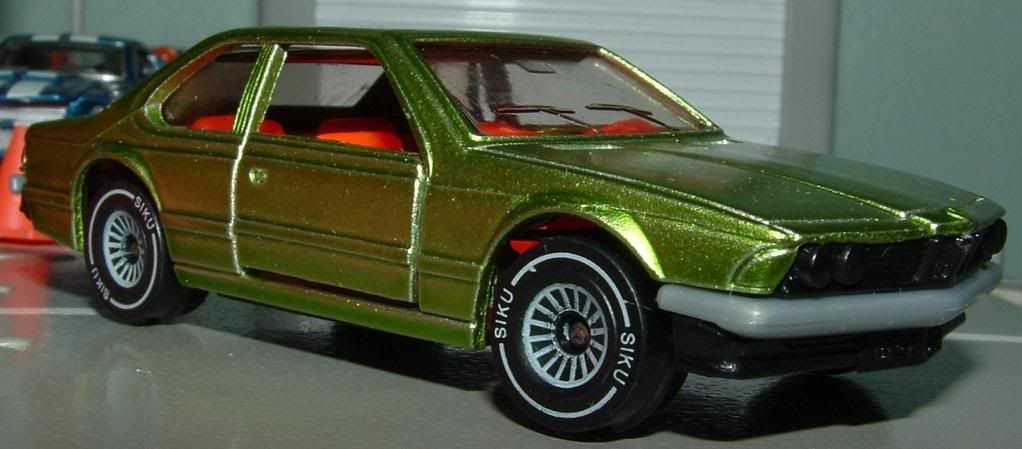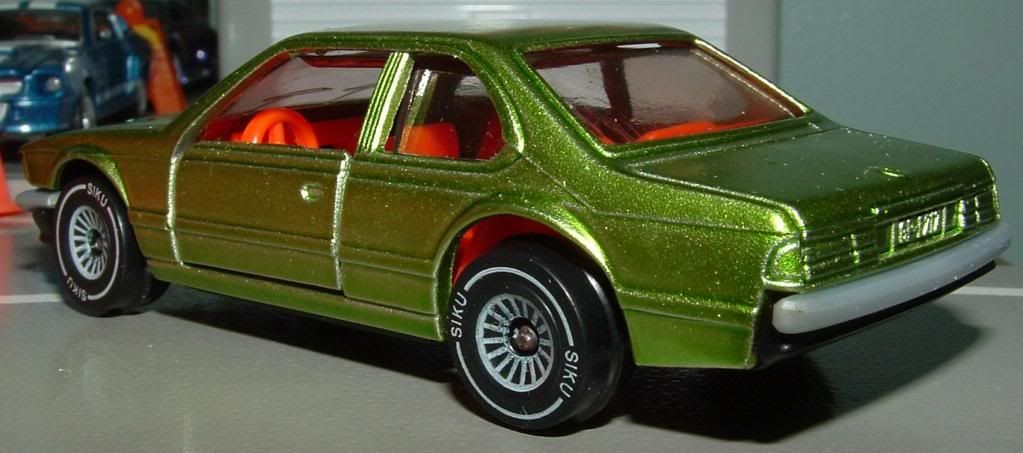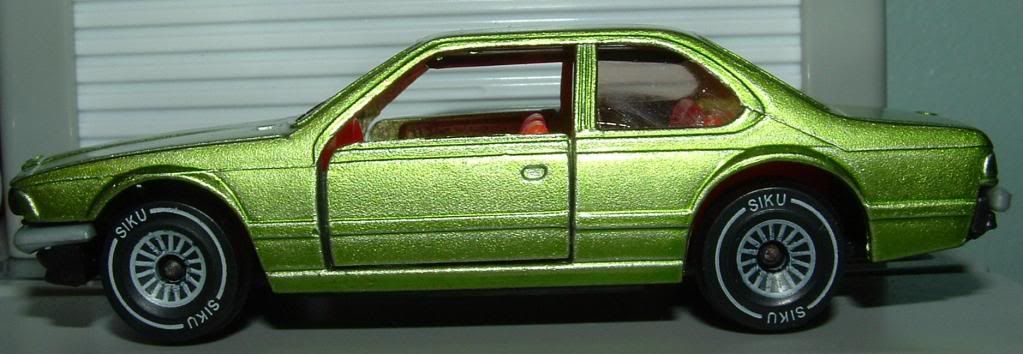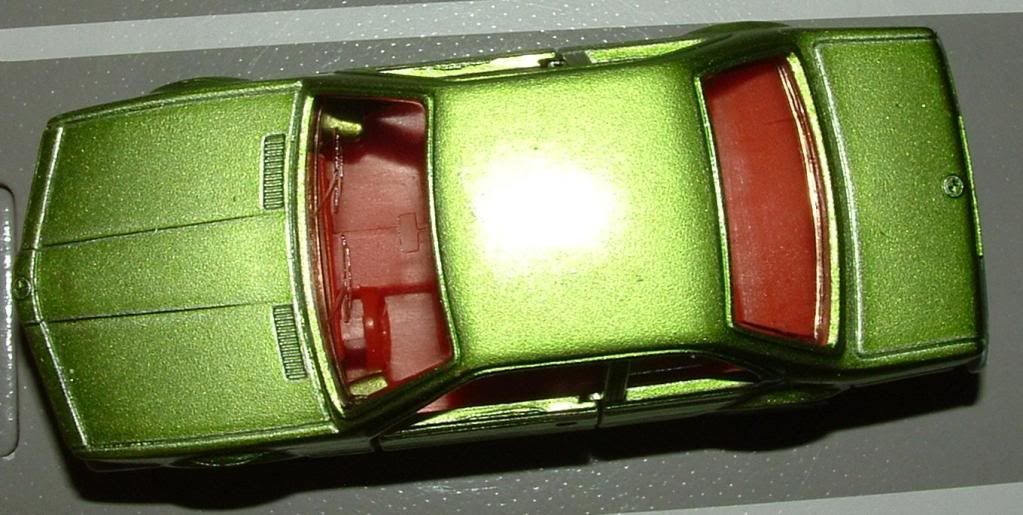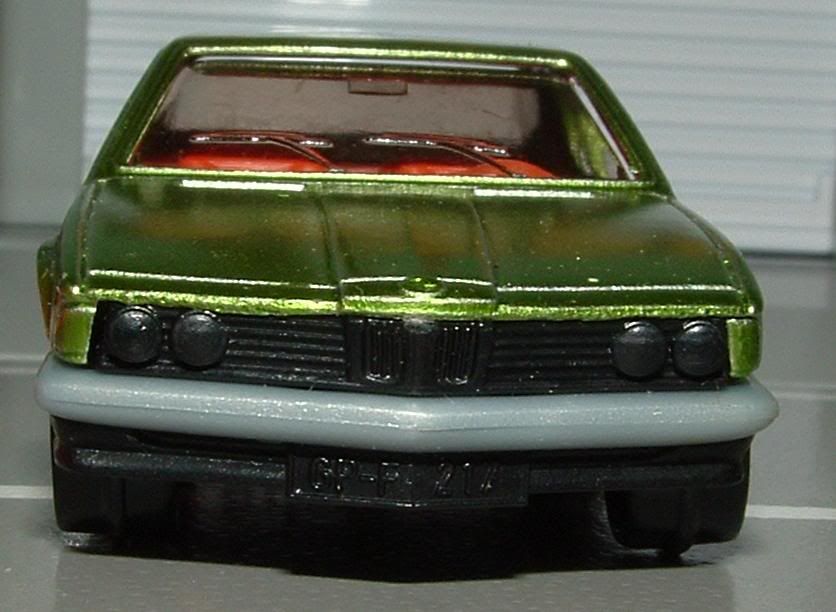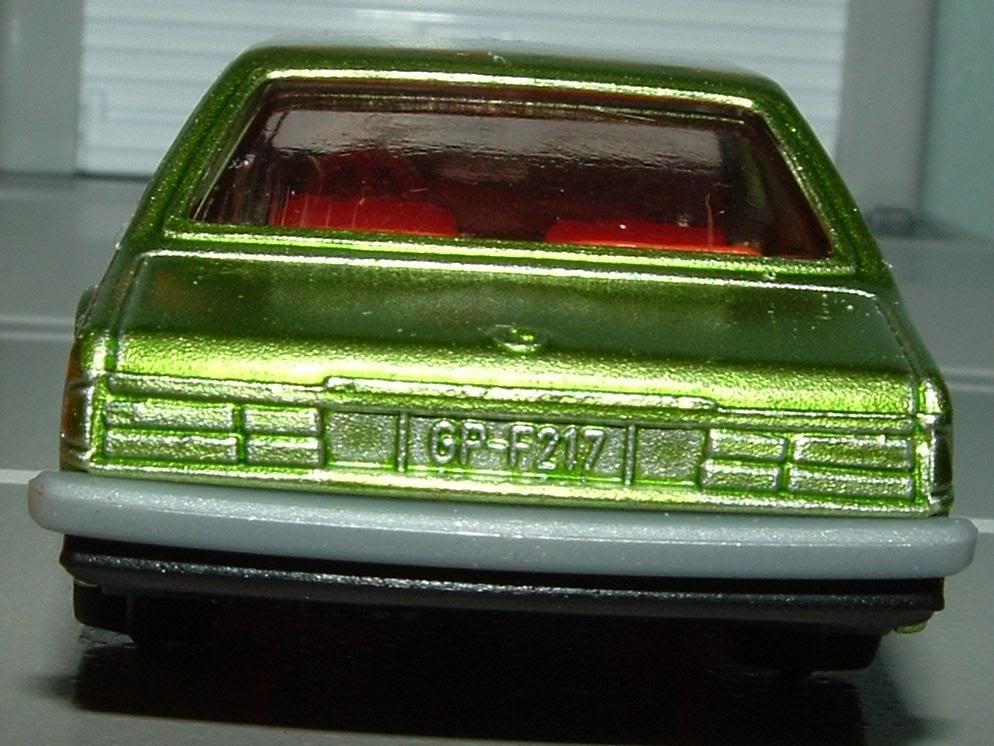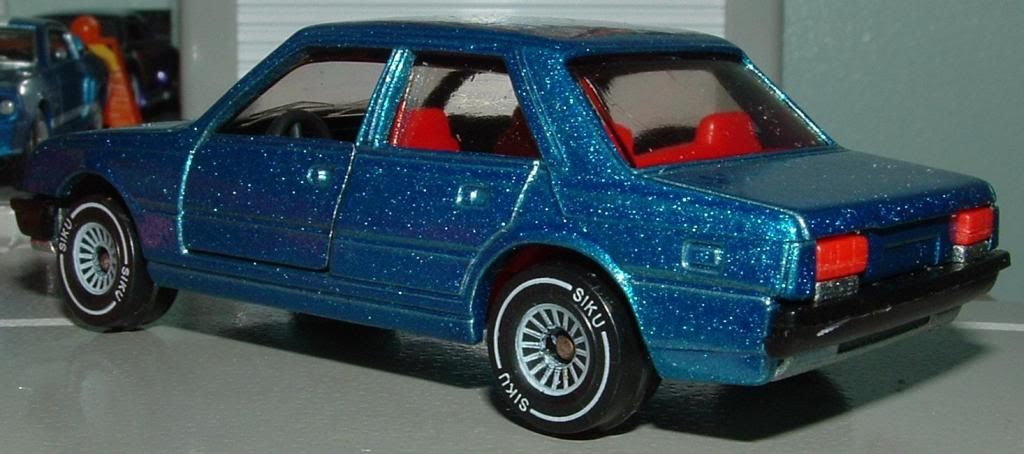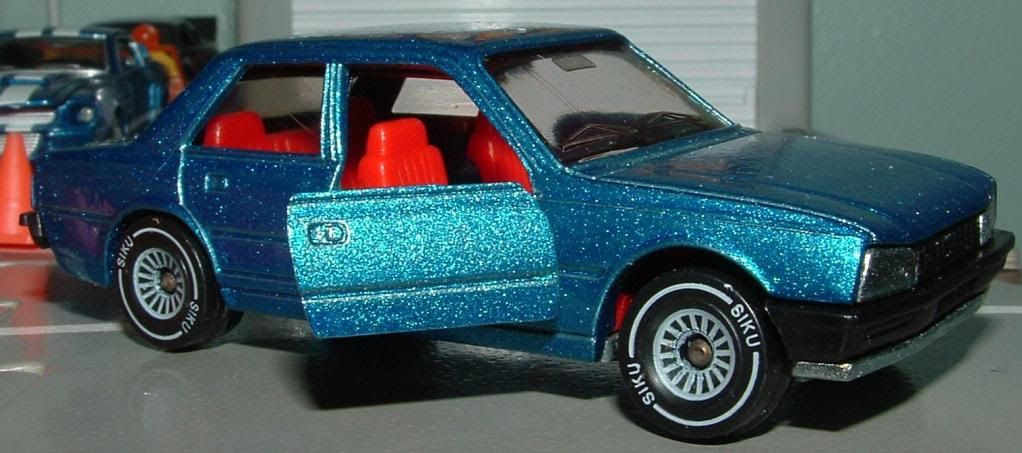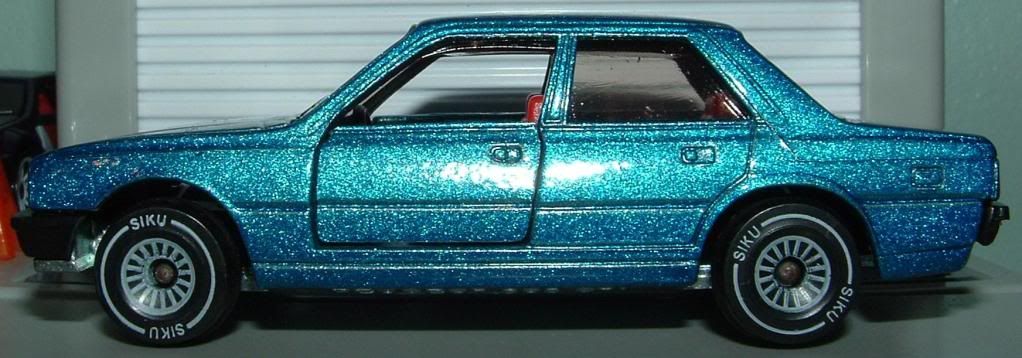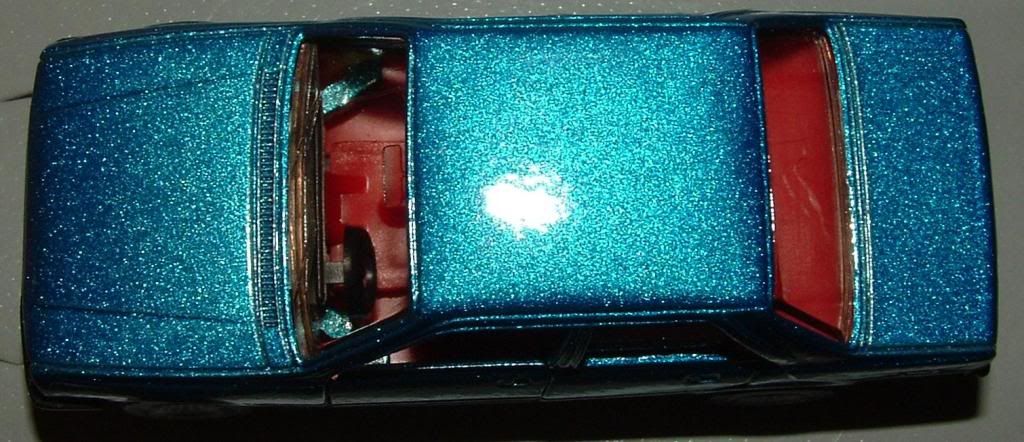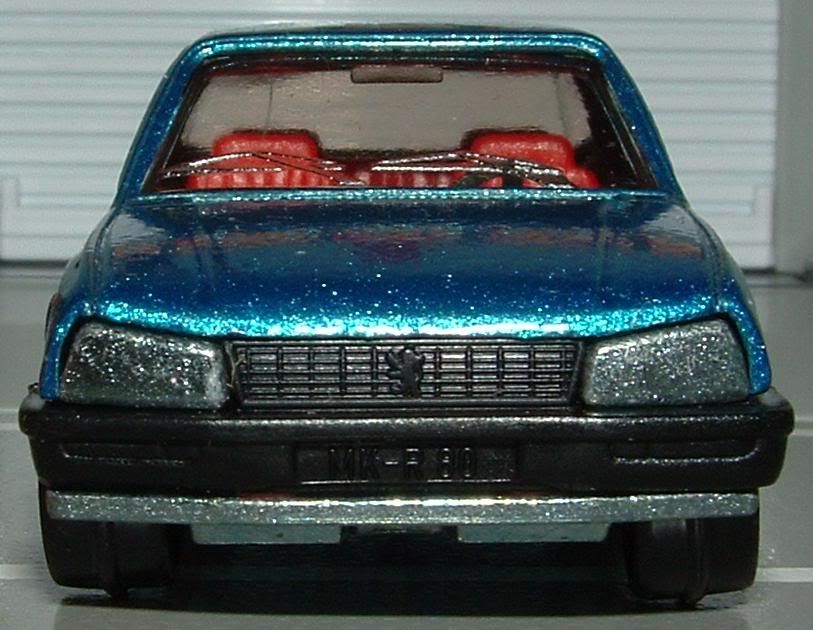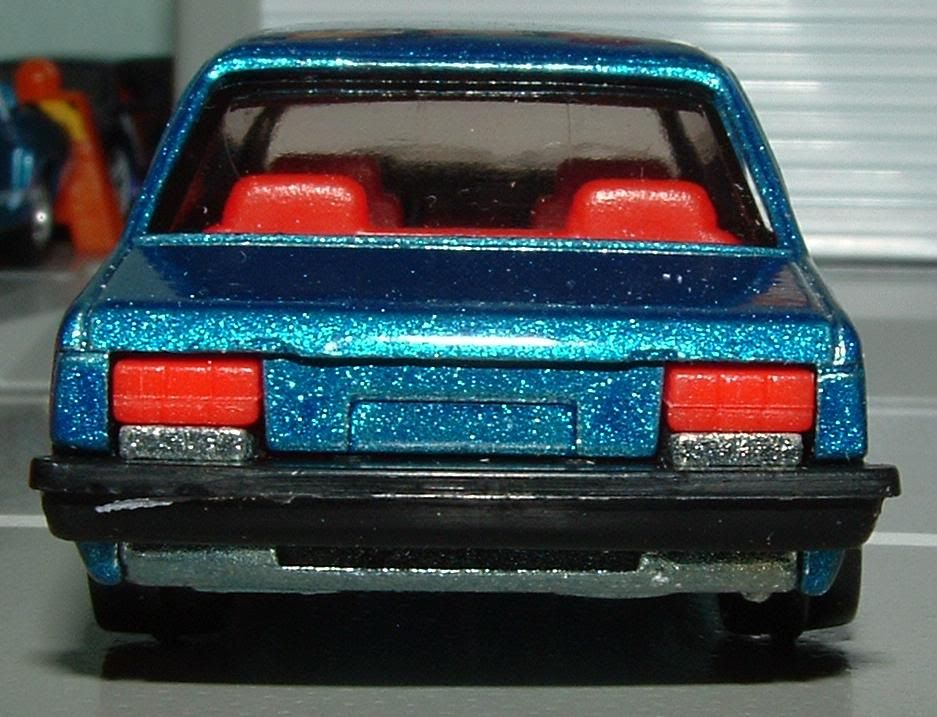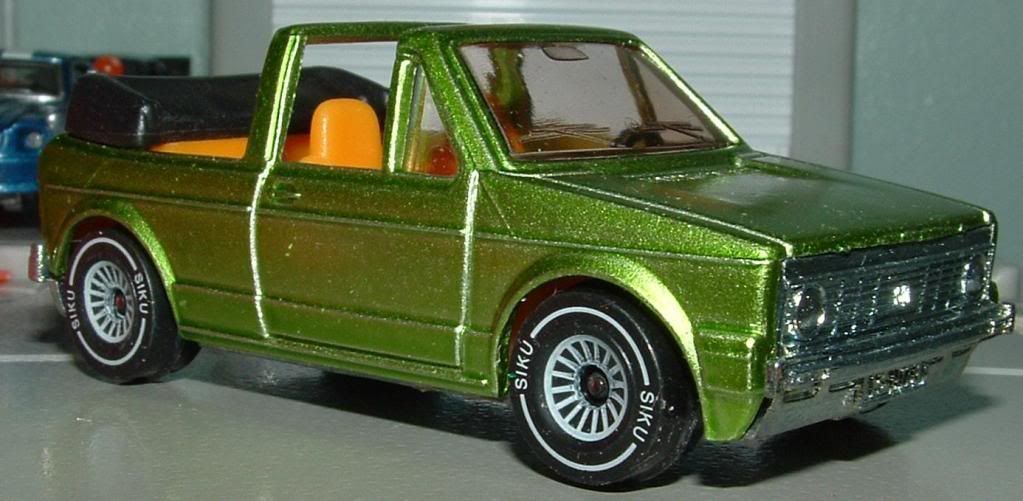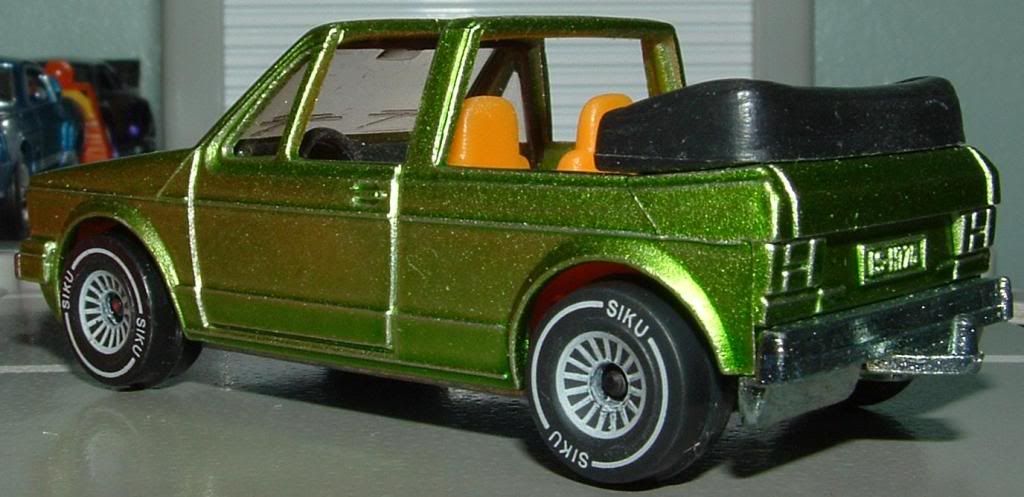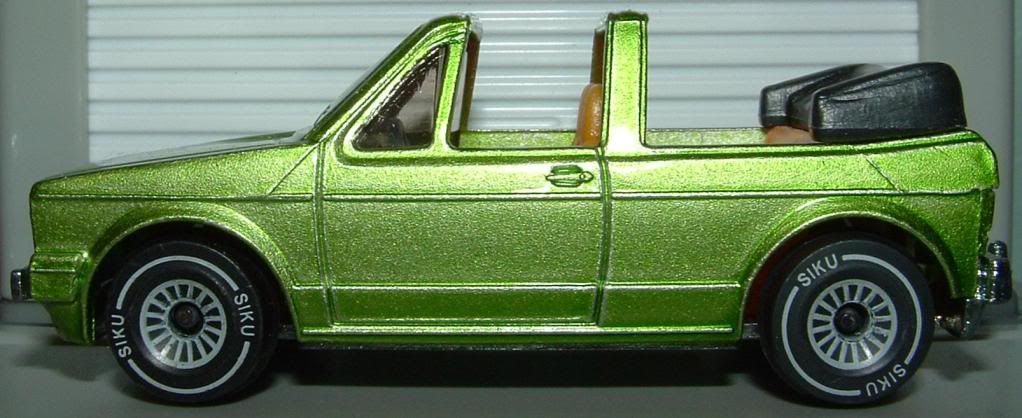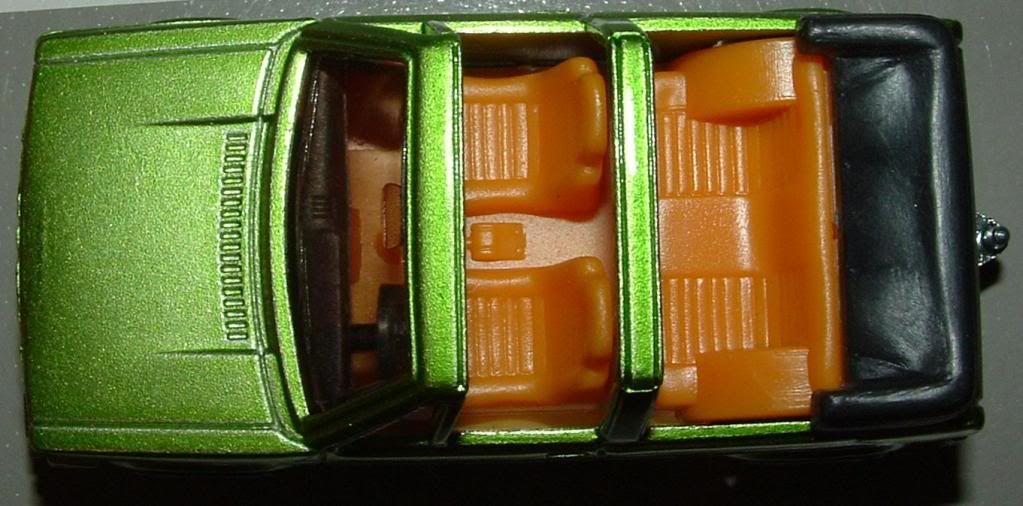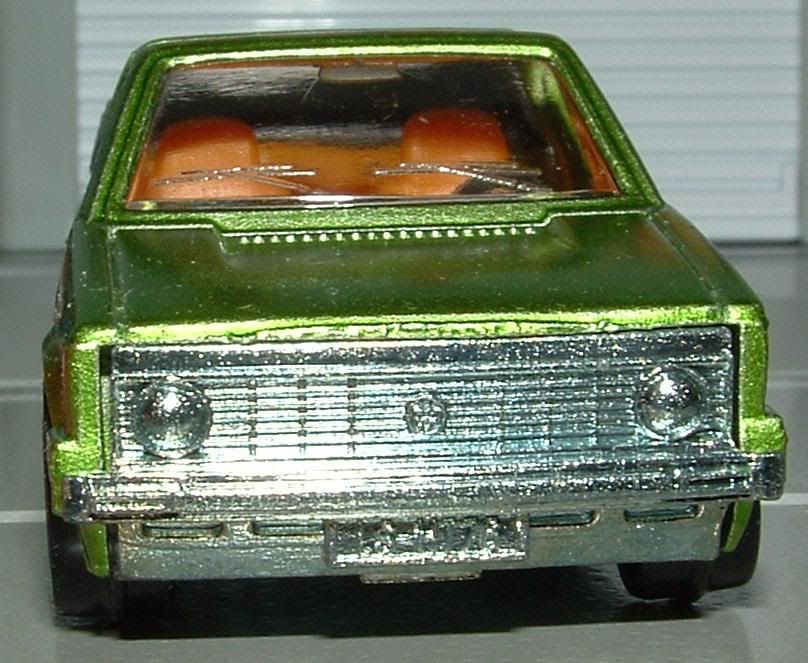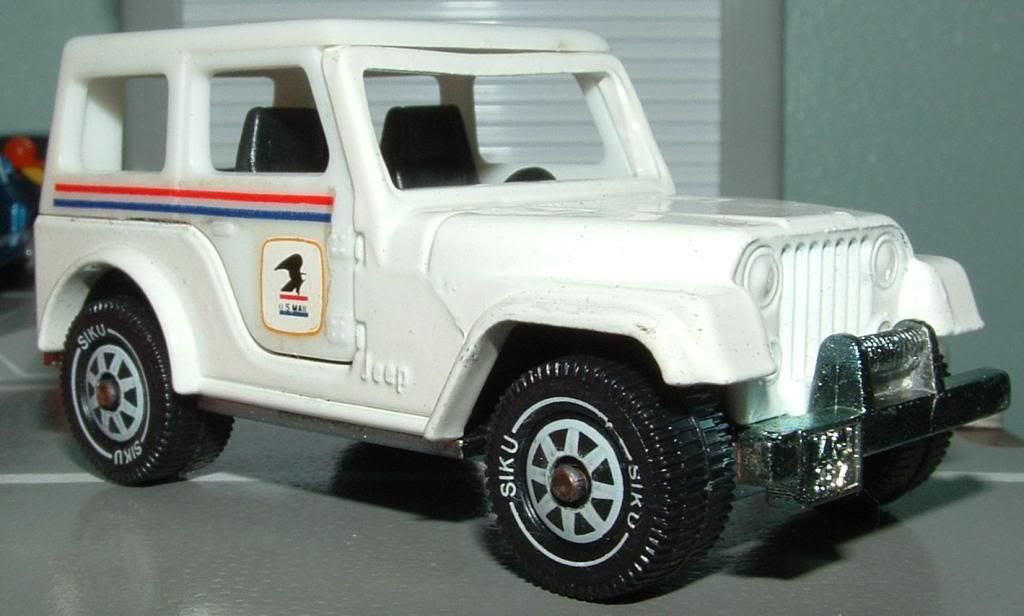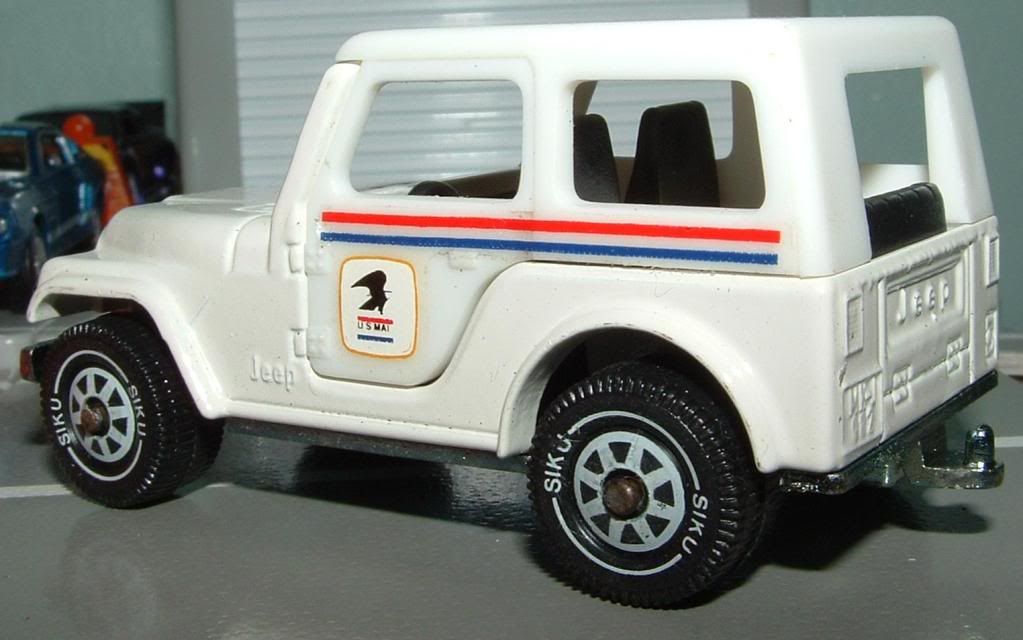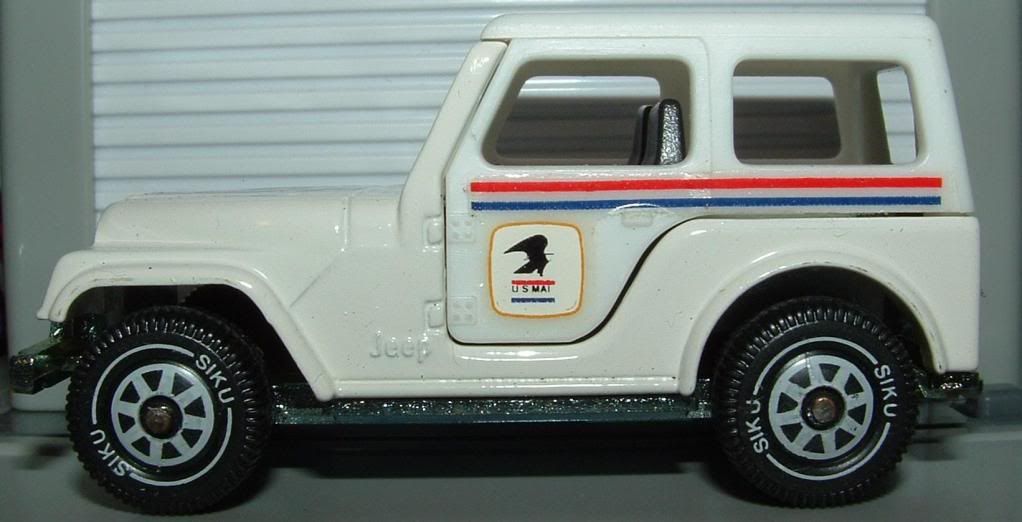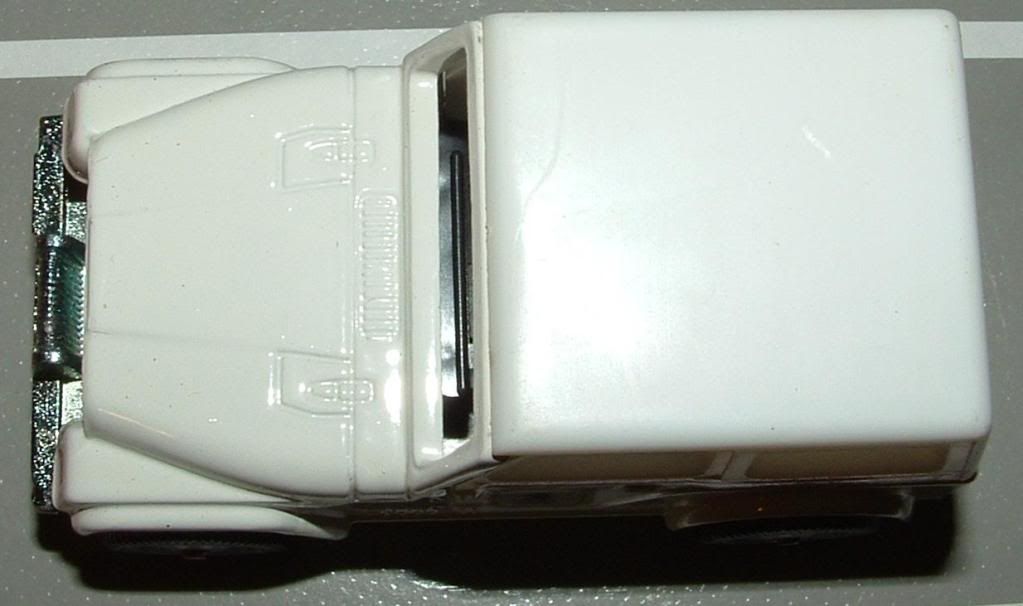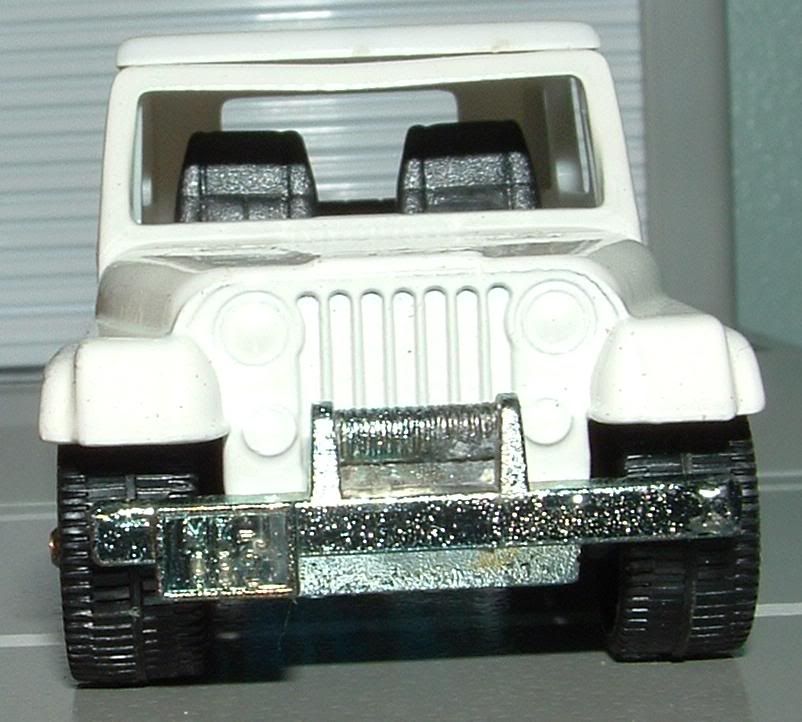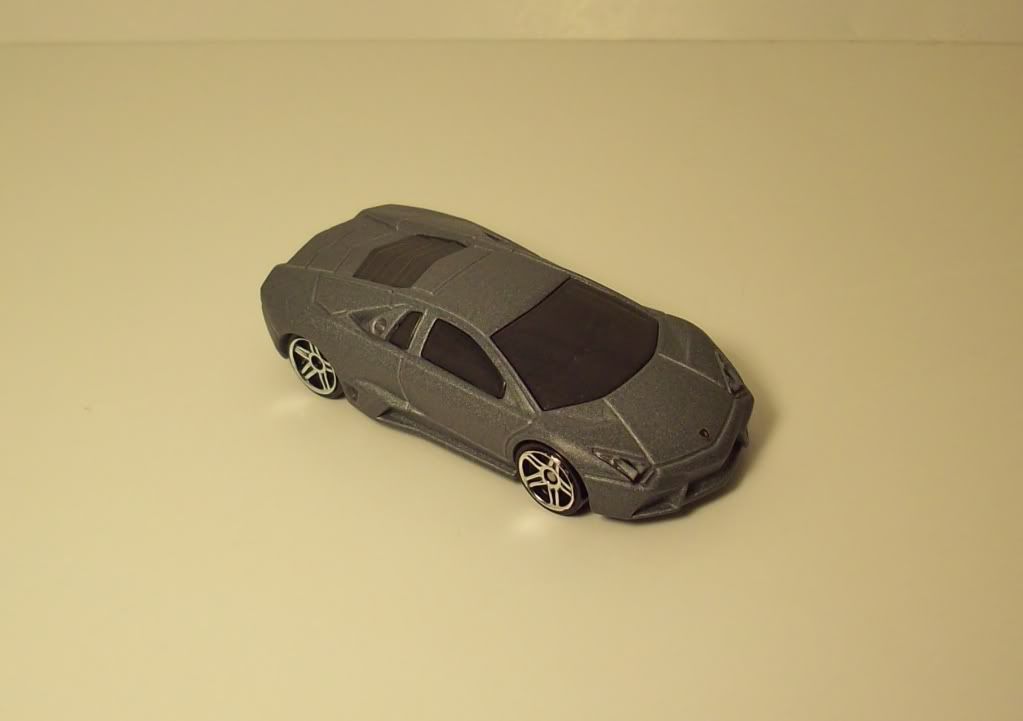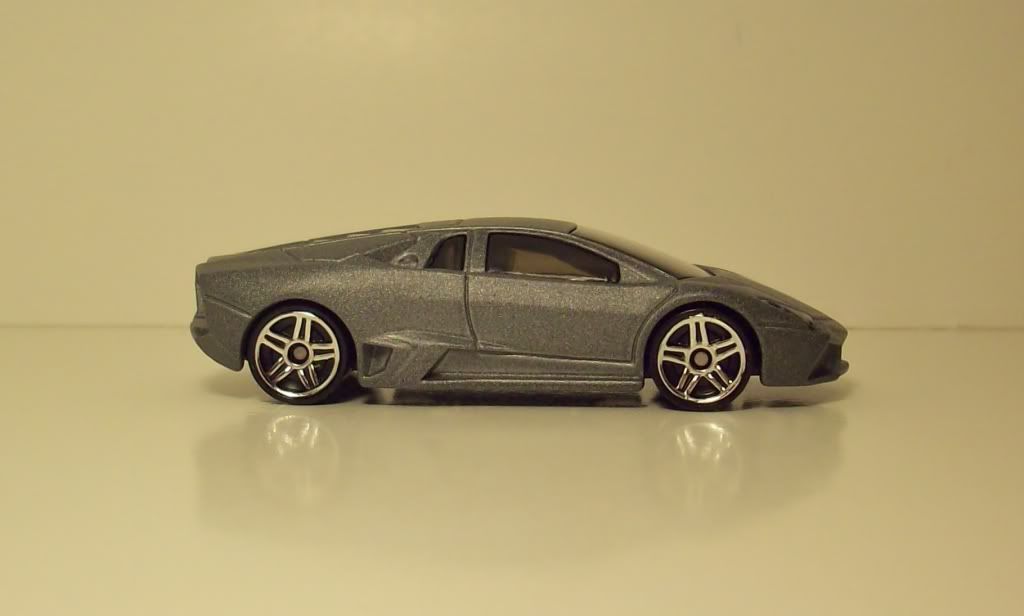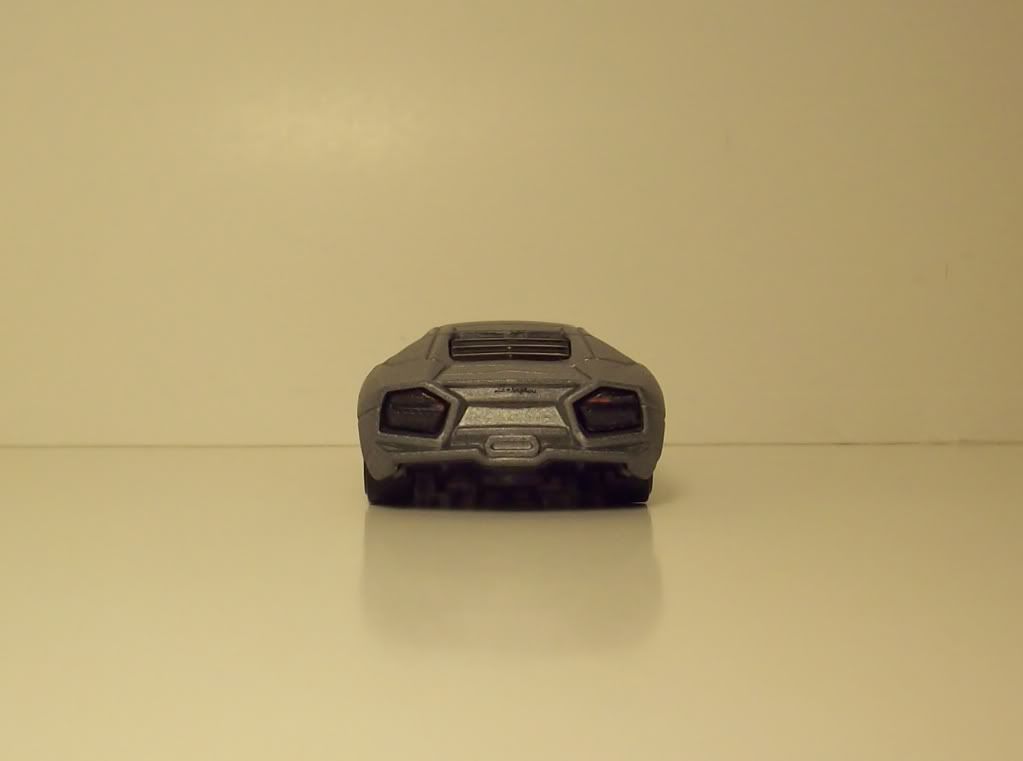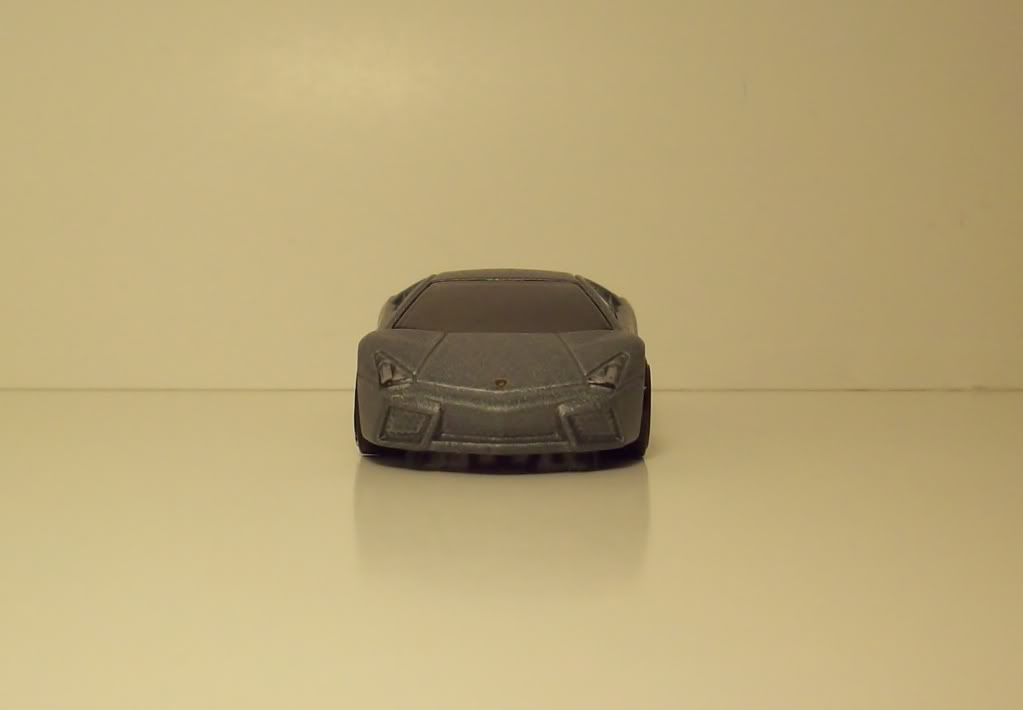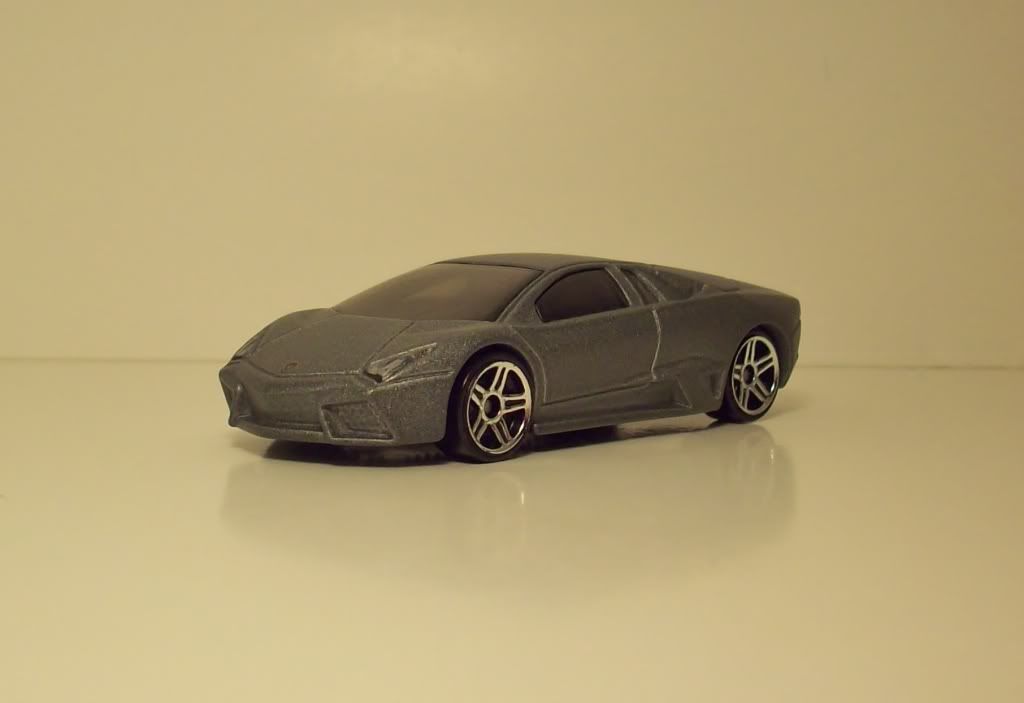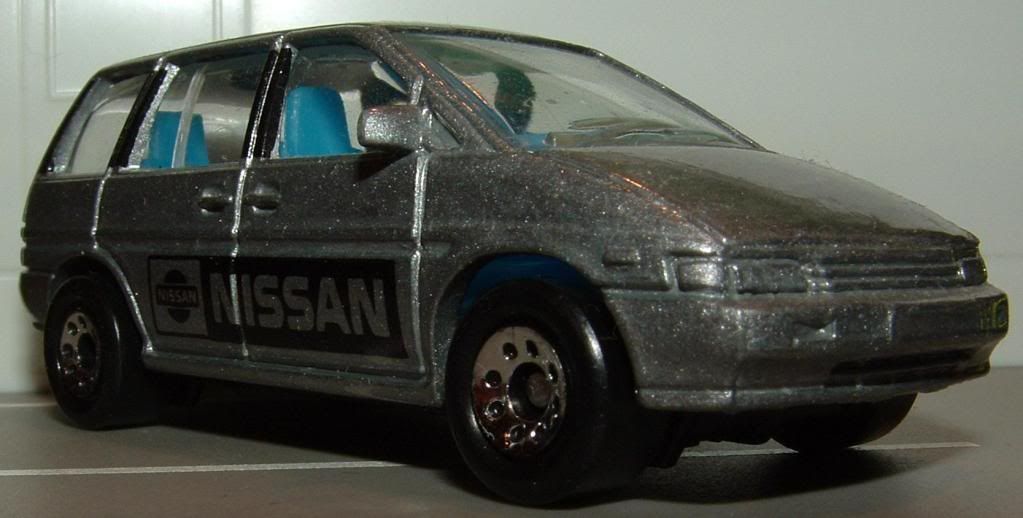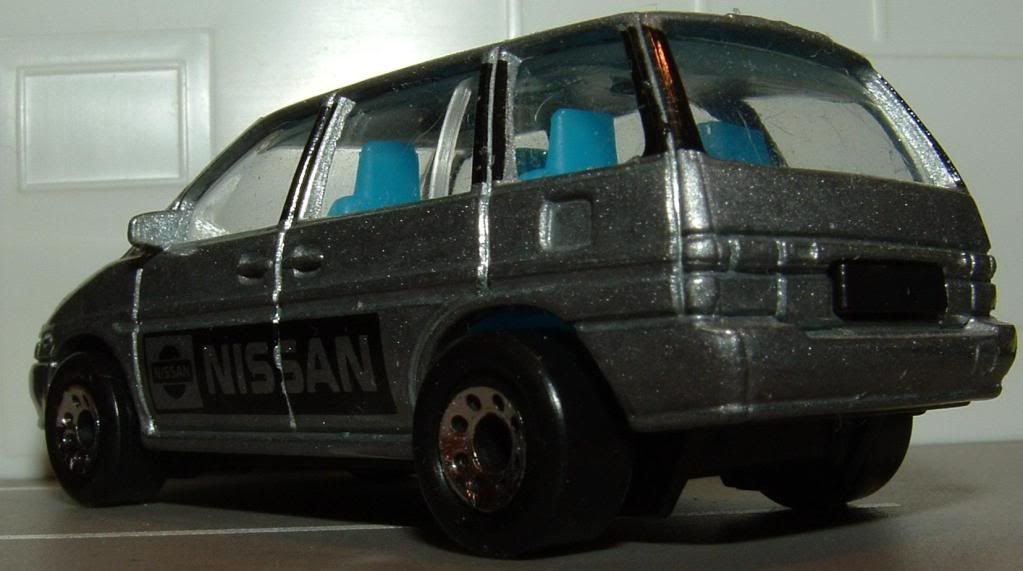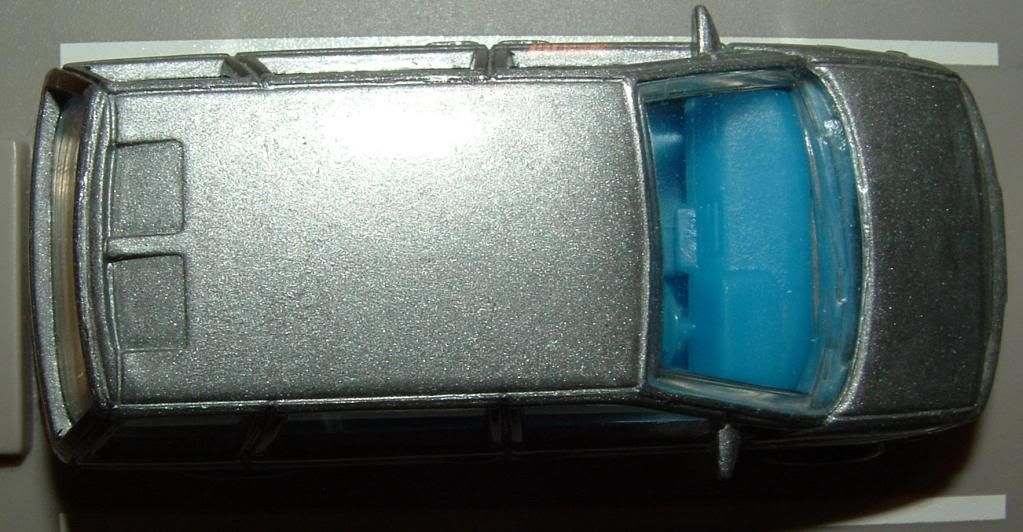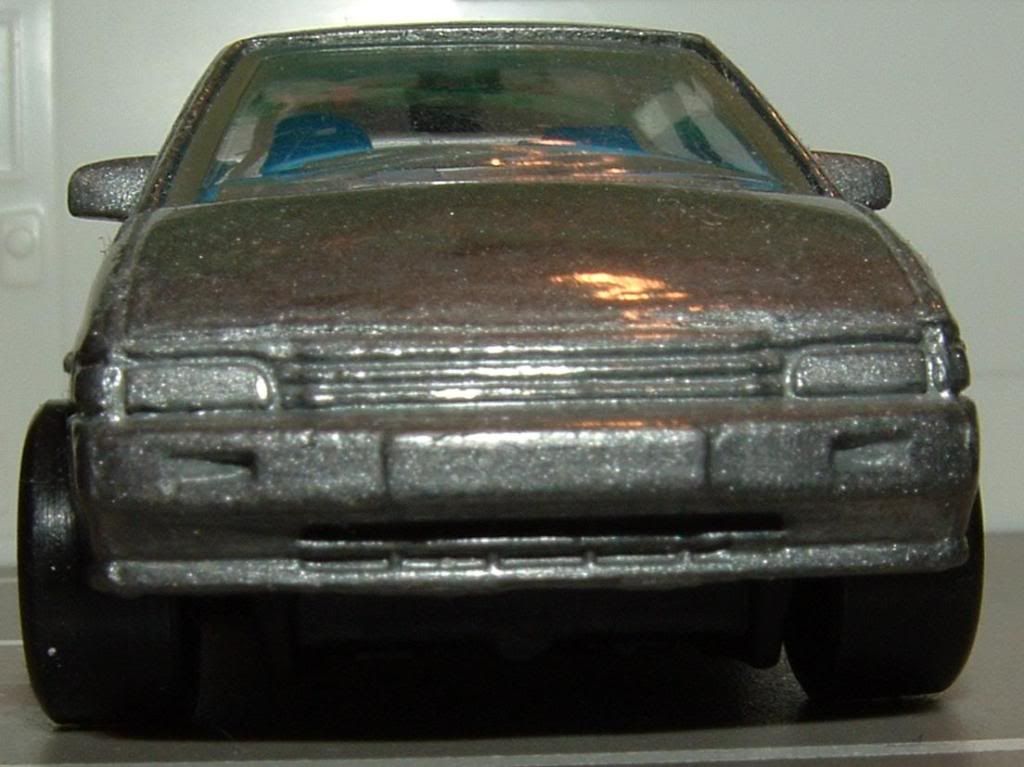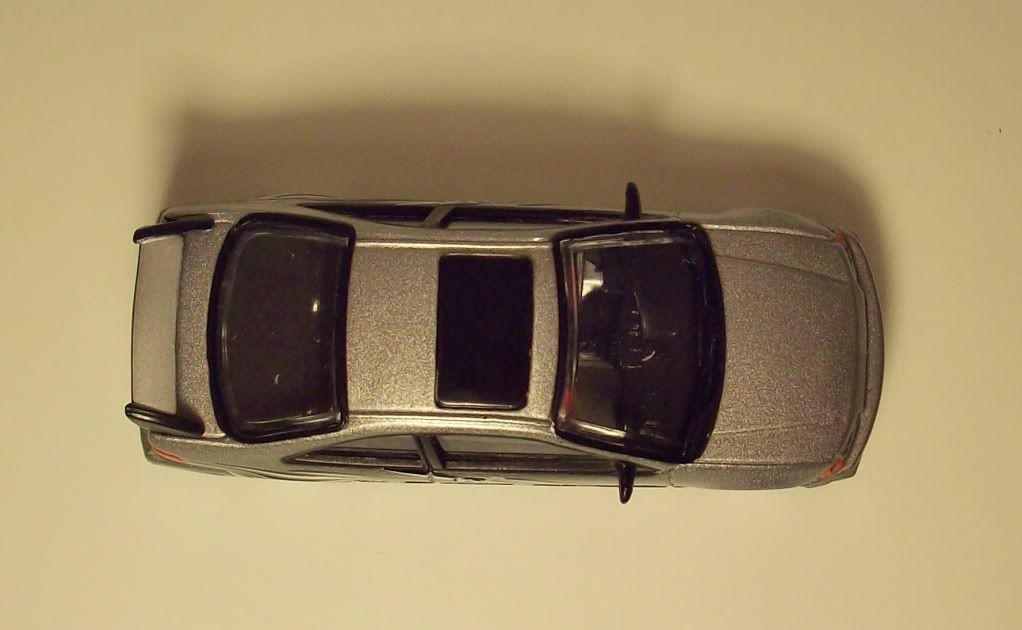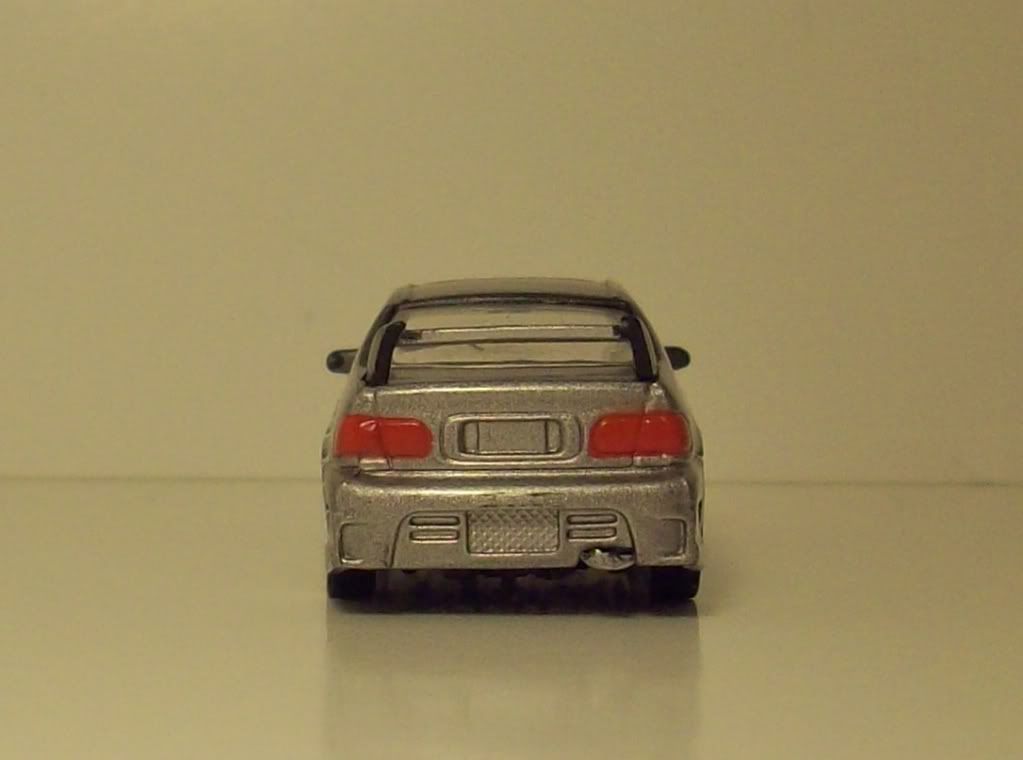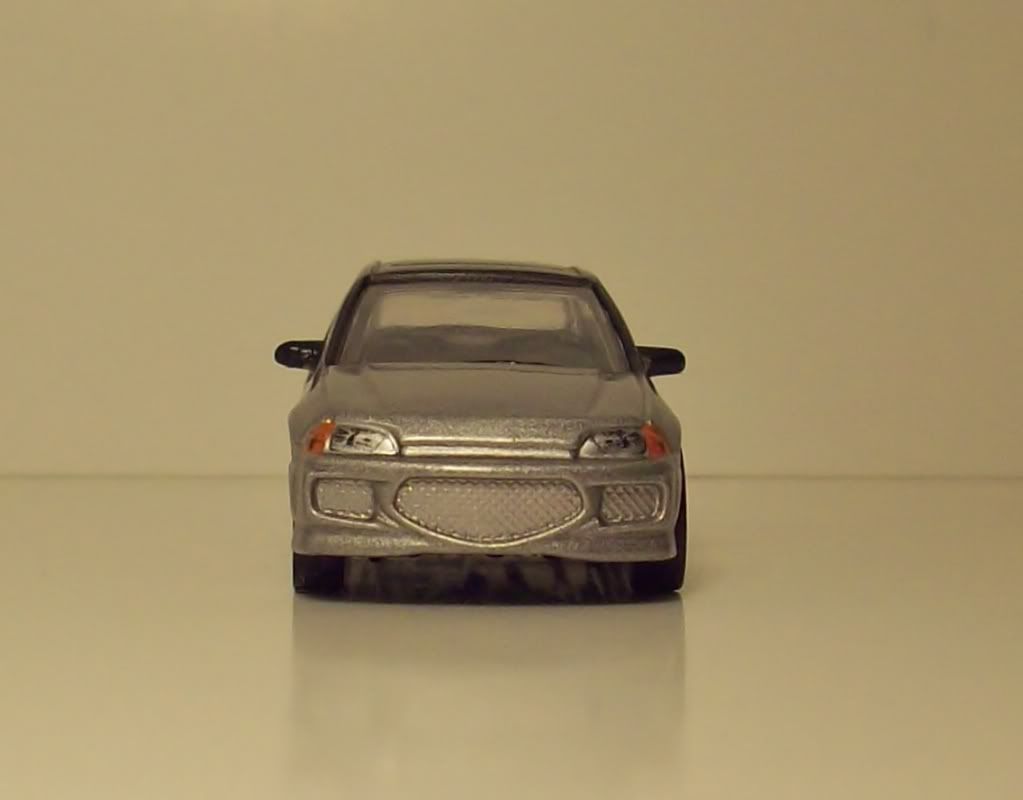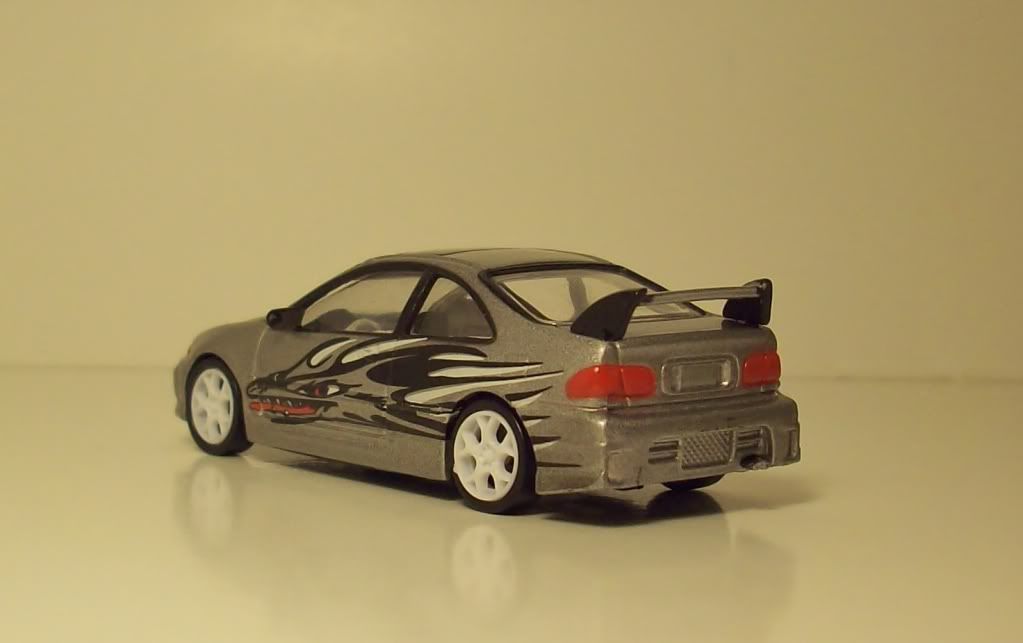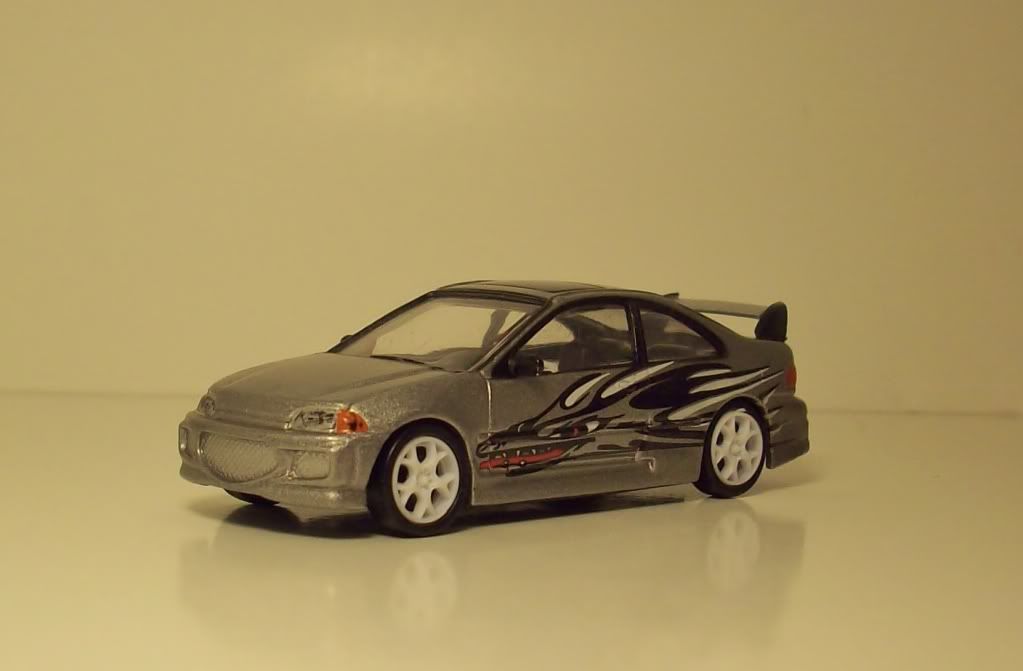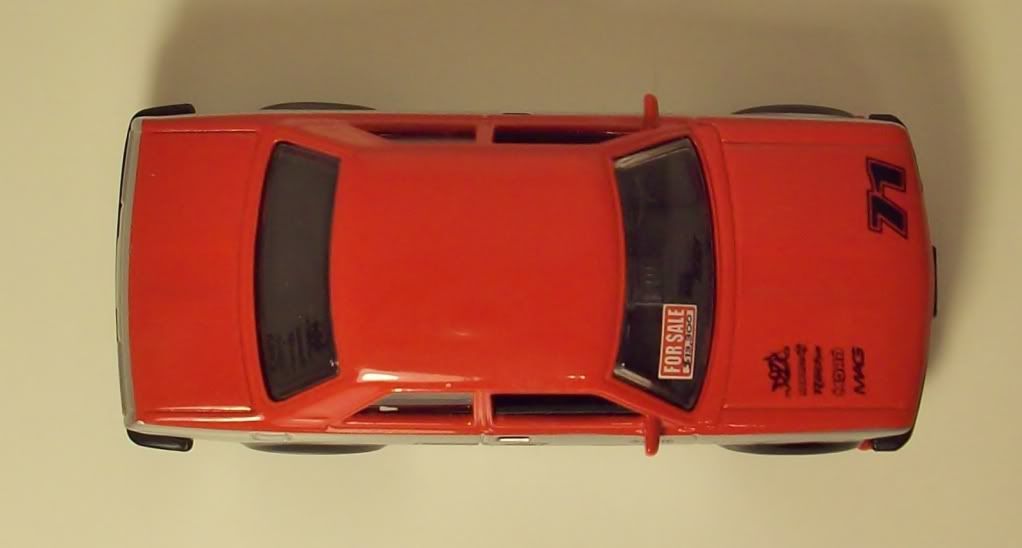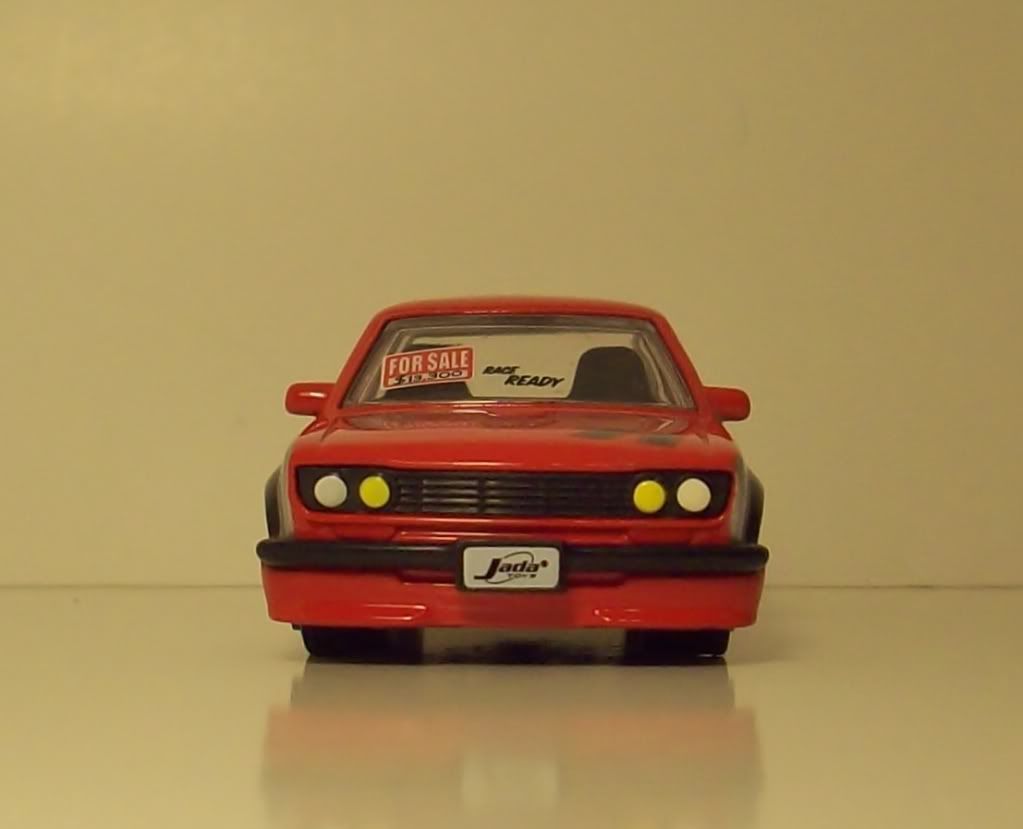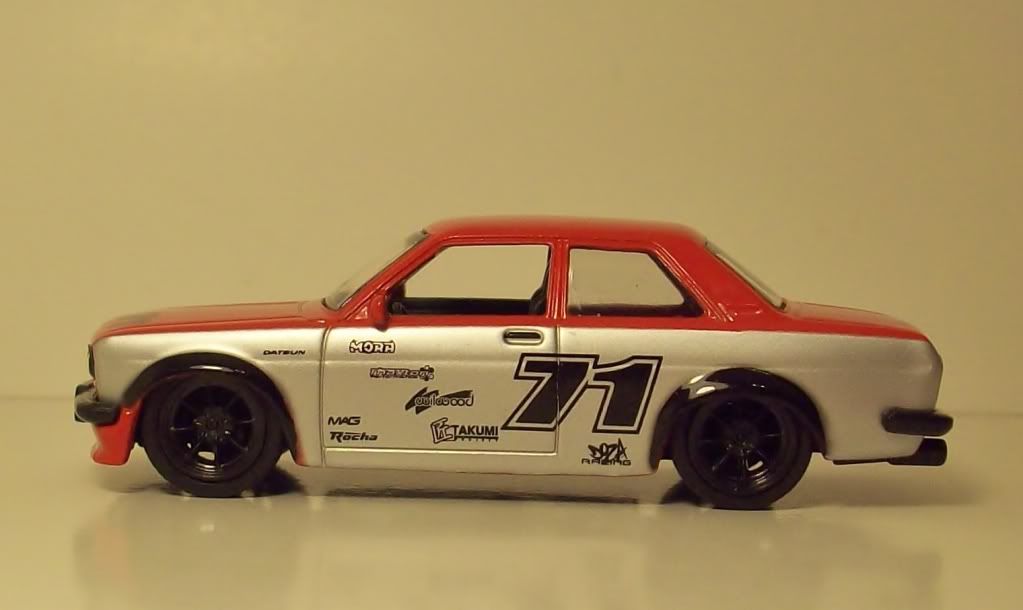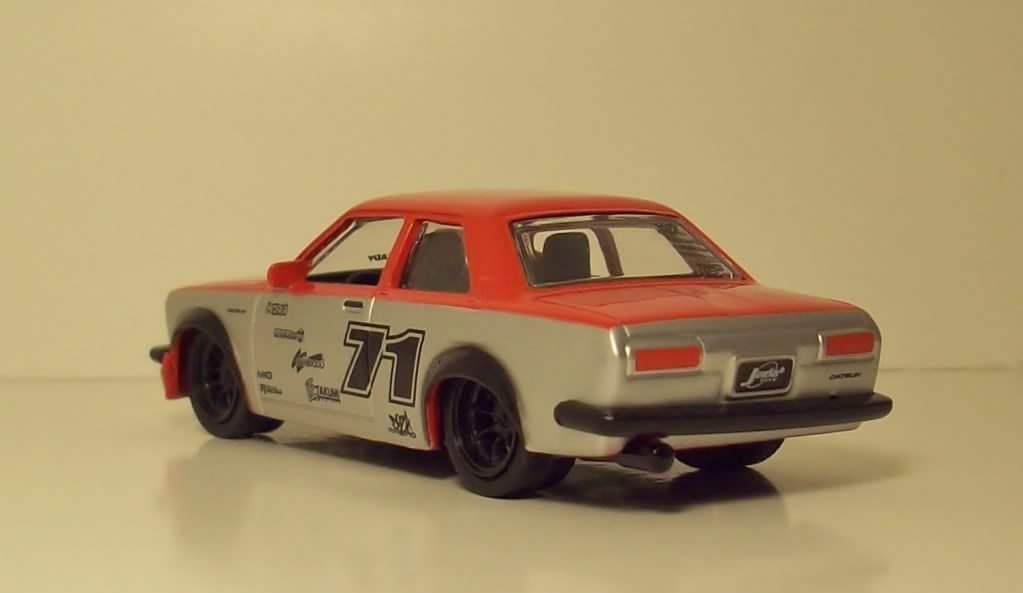
A blog focusing on 1/64 diecast from such popular brands as Hot Wheels, Matchbox, Johnny Lightning, M2 Machines, GreenLight, Tomica, Yat Ming, Majorette, MotorMax, Siku, Corgi, Guisval, Playart, Ertl, Zylmex, Racing Champions, & many more. Swifty's Garage features a daily Car Of The Day and news updates from your favorite brands!
Wednesday, August 31, 2011
Car Of The Day: August 31, 2011
Today's car of the day is Siku's 1980 BMW 633 CSi.
The BMW E24 series was the first BMW 6 Series coupé, produced by the German automaker BMW between the 1976 and 1989 model years. The 6 Series name reappeared with the BMW E63 chassis beginning in the 2004 model year. The E24 borrowed heavily from contemporary 5-series cars (E12, later E28).
For more information and pictures of the real car please visit: BMW 633 CSi
Another car from the five pack I picked up at a recent train show. In my opinion this is the weakest of the five cars in this set. Considering that Yat Ming has done a much closer to 1/64 version, this wasn't a must-have for me. I'm glad to have it though. I normally don't care about plastic bases compared to metal bases, but this is the only car in the set without a metal base. It sort of sticks out like a sore thumb in this case.
The E24 was a replacement for the CS and CSL coupés first produced in 1965. The CS 3.0 was almost changed by adding a few centimeters in height to make it easier for customers to get into the car. However, Bob Lutz rebelled against the decision and rough drafted an alternative version that soon became the 6 series. Production started in March 1976 with two models: the 630CS and 633CSi. Originally the bodies were manufactured by Karmann, but production was later taken in-house to BMW.
In July 1978 a more powerful variant, the 635CSi, was introduced (for the time being not available in North America and Japan) that featured as standard a special close-ratio 5-speed gearbox and a single piece black rear spoiler. The bigger bore and shorter stroke facilitated max 218hp at 5200rpm and a better torque curve. For the first year, the 635CSi was offered in three colors (Polaris, Henna Red, Graphite), and could also be spotted by the front air dam that did not have attached fog lights. These simple cosmetic changes reportedly worked to reduce uplift on the car at high speeds by almost 15% over the non-spoiler body shape. This early model shared suspension components with the inaugural BMW 5-series, the E12.
In 1979 the carburetted 630CS was replaced with the 628CSi; this car had a fuel injected 2.8L engine taken from the BMW 528i.
In 1980 the 635CSi gained the central locking system that is also controlled from the trunk. Also, the E24 body style converted from L-jetronic injection to a Bosch Motronic DME.
In 1982 (Europe) and 1983 (US), the E24 changed slightly, with an improved interior and slightly modified exterior. At the same time, the 635CSi received a new engine, a slightly smaller-bored and longer-stroked 3430 cc six to replace the former 3453 cc engine and became available with a wide-ratio 5-speed manual or an automatic.
E24s produced after June 1987 came with new, ellipsoid headlamps which projects beam more directly onto road surface (newly introduced E32 series also sporting them). The sleeker European bumpers were also discontinued. Previous cars had either a European-standard bumper or a larger, reinforced bumper to meet the US standard requiring bumpers to withstand impact at 5 mph (8 km/h) without damage to safety-related components. 1989 was the last year for the E24 with production stopping in April. The E24 was supplanted by the considerably heavier, more complex, and more exclusive E31.
BMW Motorsport introduced M 635 CSi in Europe at the Frankfurt Motor Show in 1983. It is essentially an E24 powered by the powerplant of the BMW M1 - the M88 (286 PS (210 kW; 282 hp)). Most of the cars were equipped with special metric 415 mm diameter wheels requiring Michelin TRX tires. A catalyzed, lower compression ratio version of the car with the S38 engine (260 PS (190 kW; 260 hp)) was introduced in the U.S. in 1987. All M6 cars came standard with a 25% rear limited slip differential. U.S. models included additional comforts that were usually optional on models sold in Europe such as Nappa leather power seats and a dedicated rear A/C unit with a center beverage chiller. Car and Driver tested a U.S. M6 in July 1987 and achieved a 0-60 time of 6.1 seconds, better than the BMW published 6.4 and 6.8 second times for the European and U.S. versions respectively. 4,088 M 635CSi cars were built between 1983 and 1988 with 1,767 U.S. M6 built.
Tuesday, August 30, 2011
Car Of The Day: August 30, 2011
Today's car of the day is Siku's 1980 Peugeot 505.
The Peugeot 505 is a large family car produced by the French manufacturer Peugeot from 1979 to 1992 in Sochaux, France. It was also manufactured outside France, for example in Argentina by Sevel from 1981 to 1995, China, Indonesia and Nigeria.
For more information and pictures of the real car please visit: Peugeot 505
Another car from the five pack I picked up at a recent train show. This casting is fantastic. Hot Wheels also did the 505.
The 505 was the replacement for the 504, available in sedan/saloon and station wagon/estate, including an 8-passenger Family Estate. The styling was similar to the 504. It is known as the "Work Horse" of Africa today.
The 505 was praised by contemporary journalists for its ride and handling, especially on rough and unmade roads; perhaps one reason for its popularity in less developed countries. "Remember that the 505´s predecessor, the 504, had an outstanding ride. It took a British-market model on a hard charging drive across the green lanes of the Chilterns. The impacts were well suppressed and the car veritably floated over the undulations and potholes. I concluded that the 505 is as good as the 504 (but no better)." The 505 also had good ground clearance; if it wasn't enough though, Dangel offered a taller four-wheel drive version of the 505 estate equipped with either the intercooled turbodiesel 110 hp (81 kW) engine or the 130 hp 2.2 L petrol (96 kW) engine. The four wheel drive 505 also had shorter gear ratios.
The interior styling was viewed positively in contemporary reviews: "Having settled into the 505's neat cockpit one notices how handsomely styled it all would appear to be. The tweed seats and brown trim look smart and less confrontational than offerings from a certain other French marque." But the ergonomics were criticised too: "The ashtray was competitively sized but is placed directly behind the gearstick. For British market cars, this will be a constant nuisance while our continental cousins will consider the placement quite logical and natural."
The range was given a facelift, including an all new interior, in 1986, but European Peugeot 505 production began to wind down following the launch of the smaller Peugeot 405 at the end of 1987. Saloon production came to a halt in 1989, and estates in 1992, some time after the introduction of the larger Peugeot 605.
In some countries such as France and Germany, the 505 estate was used as an ambulance, a funeral car, police car, military vehicle and as a road maintenance vehicle. There were prototypes of 505 coupés and 505 trucks, and in France many people have modified 505s into pickup trucks themselves.
The 505 was one of the last Peugeot models to be sold in the United States, with sedan sales ending there in 1990 and wagon sales in 1991. The last versions sold had PRV's 2.8 V6 engine only. Both the sedan (saloon) and station wagon (estate). 505s were also sold in Australia (where they were assembled by Leyland Australia from 1981 to 1983.), Argentina, Chile, China, and New Zealand. In New York City, Peugeot 505s were used as taxicabs.
The car was summed up as follows by motoring writer Archie Vicar: "The 505 is a saloon with quite a pleasant appearance, quite efficient engines, quite comfortable seating, quite nice steering and a quite reasonable price. And it is quite well constructed. So, you might say it was merely average. But can it really be that simple? Have Peugeot in fact, played a very clever game where, instead of dazzling us with technology or breathtaking styling, they have decided to woo us with understatement of the profoundest kind?"
505 models varied very much in equipment. Base SRD cars with the 2304 cc diesel engine didn't even have power steering, but the GTD Turbo, the GTI, the V6, and the TI all had power steering, central locking doors, air conditioning, a 5-speed manual transmission, moonroof (except the GTD Turbo), and front fog lights. In the V6, the power steering was speed-sensitive, the central locking doors came with an infrared remote, and the heating and ventiliation systems included electronic climate control. A 3-speed automatic transmission was available on early 505s, which was later replaced by a 4-speed unit. The most durable 505 model proved to be the GTD with a 5-speed manual transmission. In Australia, the 505 was sold as a GR, SR, STi, or GTi sedan, or an SR or GTi 8-seater station wagon, all with petrol engines. Very few GRD and SRD diesel-engined 505s were sold in Australia. The Series II update saw the SR replaced with an SLi.
The United States and Canada had their own 505 body. Notable differences were: gas tank moved inwards (now behind rear bench), with filling neck on rightside, different style quad headlamps, taillights (pre-1986 sedans), distinctive whip antenna moved from roof to rear fender (and changed to telescopic), larger bumpers, tailpipe moved from right to left. Fewer engines were offered, all detuned to meet more restrictive emission standards. The models sold in North America were: Base, "GL", "S", "GLS", "STI", "DL", "Liberté", "STX", "Turbo", "GLX", "SW8", "V6", "Turbo S", and in 1983 the "Anniversary Edition", which was sold in a limited quantity. All North-American bound 505's were built in Peugeot's Sochaux Plant, in France. The Turbo estate version was unique to the North American markets.
Monday, August 29, 2011
Car Of The Day: August 29, 2011
Today's car of the day is Siku's 1980 Volkswagen Golf GLS (Cabrio).
The Volkswagen Golf Cabriolet is the cabriolet version of the Volkswagen Golf hatchback. Initially based on the Volkswagen Golf Mk1, and the later Volkswagen Golf Mk3, and the current Volkswagen Golf Mk6. It was produced by Karmann at Osnabrück for Volkswagen Passenger Cars. There was no Golf Cabriolet produced from the Volkswagen Golf Mk2, Volkswagen Golf Mk4 and the Volkswagen Golf Mk5.
For more information and pictures of the real car please visit: Volkswagen Golf Cabriolet
Continuing vintage Siku week, we have the first of five cars bought in a 5 car (with car carrier) set at a train show in Maryland a few weeks back. I've always loved the first generation Rabbit (I have no clue why, I just do) and the Cabrio is no exception.
The Volkswagen Golf Mk1 Cabriolet was introduced in 1979, and was succeeded by the Golf Mk3 Cabriolet in 1993.
The Golf Cabriolet (or Typ 155) in Europe and Canada ("Rabbit Convertible" in America originally and renamed for the 1985 model year to "Cabriolet"), was sold from 1979 to 1993. (a convertible version of the Mk2 Golf was not made). It had a reinforced body, transverse roll bar, a high level of trim, and kept the pre-1980 style of rear lamp clusters from the Mk1 VW Golf.
The Mk1 Cabriolet is of unibody construction built entirely at the factory of Karmann, from stamping to final assembly; Volkswagen supplied the four-cylinder engine, suspension, interior, etc. for Karmann to install. The vinyl tops were insulated and manually or hydraulically operated, with a heated glass rear window.
The body of the Cabriolet did not change through the entire production run except for a larger fuel tank and smaller spare tire introduced in the 1984 model year.
In an attempt by Volkswagen to keep the car's styling current, all Cabriolets from 1988 on were fitted with a "Clipper" kit out of the factory.
There were a few special editions of the Cabriolet including the Etienne Aigner, Carat, Wolfsburg, and Best Seller editions.
Sunday, August 28, 2011
Car Of The Day: August 28, 2011
Today's car of the day is Siku's 1980 Jeep CJ-5.
The Willys CJ (later Jeep CJ) (or Civilian Jeep) is a public version of the famous Willys Military Jeep from World War II.
The first CJ prototype (the Willys CJ-2) was introduced in 1944 by Willys, and the same basic vehicle stayed in production through seven variants and three corporate parents until 1986.
A variant of the CJ is still in production today under license. The last CJs, the CJ-7 and CJ-8, were replaced in 1987 by the Jeep Wrangler.
Also available were two-wheel-drive variants, known as DJs.
For more information and pictures of the real car please visit: Jeep CJ-5
The Jeep is one of the quintessential vehicles in real life, and it's not surprising that this translates to 1/64 also. You'd be hard-pressed to name a manufacturer of small scale diecast that's done more than one hundred castings and not done a Jeep MB, CJ, and/or Wrangler among them. Matchbox definitely did the most Jeeps, but as you see here, even Siku got in on the action. For this particular release they've dressed it up in USPS colors. Technically that would make this an American Motors General DJ-5 instead of a Jeep CJ-5. Siku models of the time had the stats for the real vehicle on the back of the packaging, and I've included that along with the pictures of the vehicle. I recently picked this up at a train show in Maryland, mint on card, for $1.50. Some of my other finds from that show will be showcased this week as well.
The Willys CJ-5 (after 1964 Jeep CJ-5) was influenced by new corporate owner, Kaiser, and the Korean War M38A1 Jeep. It was intended to replace the CJ-3B, but that model continued in production. The CJ-5 repeated this pattern, continuing in production for three decades while three newer models appeared. "The CJ-5 has the distinct honor of being a vehicle that was hard to kill off... equaling the longest production run of note." A total of 603,303 CJ-5s were produced between 1954 and 1983.
From 1961 to 1965, optional for the CJ-5 and CJ-6 was the British-made Perkins 192 cu in (2.3 L) Diesel I4 with 62 gross horsepower (46 gross kW) at 3000rpm and 143 gross torque at 1350rpm.
In 1965, Kaiser bought the casting rights to the Buick 225 cu in (3.7 L) V6 Dauntless and the CJ-5 and CJ-6 got a new engine with 155 hp (116 kW) supplementing the four-cylinder Willys Hurricane engine.
A similar model, the Jeep DJ, was based on the CJ.
The company was sold to American Motors (AMC) in 1970, and the GM engine was retired after the 1971 model year. (GM's Buick division repurchased the engine tooling in the early 1970s which served as the powerplant in several GM vehicles.) The "Trac-Lok" limited-slip differential replaced the "Powr-Lok" in 1971.
American Motors began using their own engines in 1972. Replacing the Hurricane was the one-barrel 232 cu in (3.8 L) (except in California). Optional was a one-barrel 258 cu in (4.2 L) (standard in California). Also in 1972, AMC's 304 cu in (5.0 L) V8 engine became available in the same tune as a base V8 muscle car. To accommodate the new engines the fenders and hood were stretched 5 inches (127 mm) starting in 1972 and the wheelbase was stretched 3 inches (76 mm). Other drive train changes took place then as well, including the front axle becoming a full-floating Dana 30.
In 1976 the tub and frame were modified slightly from earlier versions. The windshield frame also changed meaning that tops from 1955-1975 will not fit a 1976-1983 CJ-5 and vice-versa.
In 1979, the standard engine became the 258 cu in (4.2 L) I6 that now featured a two-barrel carburetor.
From 1980 to 1983, the CJ-5 came standard with a "Hurricane"-branded version of the GM Iron Duke I4.
The DJ-5A was introduced in 1967, beginning the lettering system indicating changes within the series.
The DJ-5A (Kaiser Co.) used a standard CJ front end, with a 4-cylinder Chevrolet Nova 153 cu in (2.5 L) engine and 2-speed Powerglide automatic transmission. In 1971, this was changed to a unique 5-slot grille without turn signals that was used only on postal Jeeps. The 1971 model actually has the grille extend past the front of the hood edge. This allowed more room for the AMC Straight-6 engine and radiator. While resembling the CJ series, these were built as a completely enclosed, rear-wheel drive vehicle, with sliding doors (which could be opened while driving), and a swinging rear door. Most models only had the driver's seat and a mail tray where the second seat would normally be located. One improvement over earlier Jeeps was mounting the rear springs outside of the frame rails, thus providing greater stability for the vehicle with its top-heavy enclosed cargo area, especially at highway speeds. Most models were also equipped with a limited slip differential and a heavy-duty steering gearbox.
AM General used a variety of powerplants during production. DJ production was ended in 1984 with the DJ-5M, which used the 150 cu in (2.5 L) AMC Straight-4 engine.
Saturday, August 27, 2011
Car Of The Day: August 27, 2011
Today's car of the day comes from Firehawk73's collection and is Hot Wheels' 2009 Lamborghini Reventón.
The Lamborghini Reventón (Spanish pronunciation: [reβenˈton]) is a mid-engine sports car that debuted at the 2007 Frankfurt Motor Show. It is the most expensive Lamborghini road car to date, costing one million euros (~US$1.5 million, or ~£840,000). Its top recorded speed was recorded in Dubai, UAE at 356 kilometres per hour (221.2 mph). The official press release stated that only 20 vehicles would be sold to the public, with one additional car (marked as 0/20) produced for the Lamborghini Museum. Although early rumors indicated the total number would actually be 100, each Reventón is clearly stamped with its number in the sequence of 20 between the driver's and passenger's seats.
Despite the exterior being new, almost all the mechanical elements (including the engine) are sourced directly from the Murciélago LP640. According to the official press release, the Reventón exterior styling was inspired by "the fastest airplanes". To emphasize this, Lamborghini staged a race between a Reventón and a Panavia Tornado fighter plane on a 3 km long runway. The Reventón was in the lead for most of the race, but the Tornado caught up "in the last few feet" of the race.
For more information and pictures of the real car please visit: Lamborghini Reventón
With all of the real cars coming in one color only, this does limit repaints of this casting. Oh wait, this is Hot Wheels. We can probably expect this one with Masters of The Universe graphics next year.
The Reventón features an all-new carbon fiber exterior. All Reventóns have the same exterior color, described as "mid opaque grey without the usual shine."
Lamborghini has also picked up some of parent company Audi's design language. It is the first Lamborghini to incorporate daylight running lights into the headlamps. Seven light-emitting diodes (LEDs) at each headlamp flank the bi-Xenon main beam and stay lit whenever the car is in movement. Due to the high temperatures in the rear lower part of the car, special heatproof LEDs are used for the indicator and hazard lights, stoplights and rear lights with a triple arrow optical effect.
Friday, August 26, 2011
Minivan Of The Day: August 26, 2011
Today's car of the day is Matchbox's 1990 Nissan Prairie.
For more information and pictures of the real car please visit: Nissan Prairie
The second generation Nissan Prairie, an almost bizarre choice to appear in 1/64. Nowhere near as well-known as the Chrysler minivans (which Matchbox had already replicated six years prior), and nowhere near as distinctive as the new for 1990 GM minivans. Matchbox usually tried to pick cars with global appeal due to all the markets they competed in, and odds are good that the fact that this one debuted in North America in 1990 as the Axxess helped spur the decision to produce this model. Of course the Axxess only stuck around the USA for one model year and quickly faded away. I'm not sure I've ever seen one (though I have seen a first generation model as recently as last year).
The second generation of the Prairie was introduced September 1988, and it was renamed the Nissan Axxess when sold in North America. The vehicle sold for six years (1990–95) in Canada, and in 1990 only in the United States.
The Prairie came with optional AWD but because it came with a 2.0 litre engine, it wasn't designed or equipped for vigorous off road driving. In North America, that market segment was offered an all new vehicle, called the Nissan Pathfinder. Because of the Pathfinders similar cargo carrying capacity added to an increased ground clearance and a larger 4- and V6 engine, the utility that the Prairie(Axxess) offered was seen as a lesser vehicle.
Nissan didn't retreat from the family oriented minivan market, and introduced the Nissan Quest in 1993, sharing production facilities with Ford North America, with Ford selling the Quest as the Mercury Villager. In Europe, the Prairie was replaced with the larger Nissan Serena, also originally sold in Japan in 1991.
Nissan refocused their efforts provided by the Prairie on the Japanese market, and offered additional room by stretching the back end to better accommodate third seat passengers and load carrying, calling the vehicle the Prairie Joy, which was offered August 1995. The Prairie continued to see competition from the Toyota Sprinter Carib, the Mitsubishi Chariot, and the Civic based Honda Shuttle.
Styling of the Prairie was never its strong suit, and the second generation didn't show an improvement, which hampered sales. It was popular with families who needed utility above other considerations.
May 1997, anti-lock brakes and driver and front passenger airbags were offered, along with ultraviolet restricting tinted glass.
Thursday, August 25, 2011
Car Of The Day: August 25, 2011
Today's car of the day comes from Firehawk73's collection and is Racing Champions' 1995 Honda Civic.
Introduced in July 1991 the fifth generation of the Honda Civic had a more wedge-shaped body and the wheelbase was increased to 257 cm (101.3 inches) for the two-door hatchback and 262 cm (103.2 inches) for the four-door sedan. The wagon was also dropped for overseas markets, while the previous generation station wagon continued in Japan. This generation of Civic used lightweight materials to create a fuel efficient economy car. In addition, vehicles with the 1.6L SOHC VTEC 125 PS (92 kW; 123 hp) engines such as the Si hatchback and EX coupe models found in the United States, provoked popularity of the (relatively) high performance 1.6L I4 segment. In South Africa a unique model with the B18B3 from the Acura Integra RS was specially built to fill the gap left by the absence of the DOHC B16A VTEC engine in the range.
For more information and pictures of the real car please visit: Honda Civic
I seem to recall Racing Champions issuing this one as a 1995 model, but the Internet Movie Car Database lists it as a 1993. There was a facelift in 1994 , but the changes were minor (the most drastic was the rear spoiler, which unfortunately isn't factory on either the movie car or the diecast replica)
Trims available in the two-door coupe body style (introduced in 1993) were the DX (EJ2) and EX (EJ1) for the United States Domestic Market (USDM), and the DX, DX "Special Edition" (EJ2) and Si (EJ1) for the Canadian Domestic Market (CDM).
DX: The DX was the base model equipped with all-manual features, driver's side door mirror, rear defroster and power brakes. The 1995 Canadian-only DX "Special Edition" added an AM/FM cassette player, wheelcovers, center armrest console, clock, power steering and dual power mirrors.
EX/Si: The USDM EX/CDM Si included an AM/FM cassette player and upgraded sound system, cruise control, wheelcovers on 14-inch (360 mm) wheels, clock, 9K tachometer with 7.2K RPM redline, power steering and dual body-coloured power mirrors, with the USDM EX also receiving power locks and windows.
Wednesday, August 24, 2011
Car Of The Day: August 24, 2011
Today's car of the day comes from Firehawk73's collection and is Jada's 1971 Datsun 510.
The Datsun 510 or P510/PL510 was a series of the Datsun Bluebird sold from 1968 to 1974, and offered outside the U.S. as the Datsun 1600. According to AutoWeek's G.D. Levy, the 510 has often been called the "poor man's BMW." The 510's engineering was inspired by contemporary European sedans, particularly the 1966 BMW 1600-2, incorporating a SOHC engine, MacPherson strut suspension in front and independent, semi-trailing arms in the back. The European-influenced sheet metal design is attributed to Datsun in-house designer, Teruo Uchino.
The engine was pushed through by Nissan USA president Yutaka Katayama, a design developed through Prince, an acquisition, with some Mercedes Benz influence.
Its positive reputation led to the 510 tag being reused there for the unrelated and mediocre 1978-1981 Nissan Stanza 'H510' in an effort to capture this range’s glory, an effort reviewers thought a failure.
Launched in August 1968, it was one of the most comprehensive Bluebird ranges in terms of body styles: a two-door sedan, a four-door sedan, a five-door station wagon, and a two-door coupé (added in November 1968).
This range became famous for Nissan's rallying successes outside Japan and paved the way for greater Nissan sales internationally.
The Datsun 510 released to the U.S. market came originally with the Hitachi downdraft carbureted 1.6L L-series I4 engine, with an advertised gross power of 96 hp (72 kW), a claimed top speed of 100 mph, front disc brakes, 4-wheel independent suspension (MacPherson strut front and semi trailing arm rear- wagons had a solid rear live axle and leaf springs in back), rear wheel drive, and either a 4-speed manual or a 3-speed automatic transmission. 2-door sedan, 4-door sedan, and 4-door station wagon variants were available. It achieved 20-30 mpg in factory trim (U.S.). JDM spec models were also available in a 2-door coupe body style in either a 1.6L or a 1.8L (1973) L-Series engine. 510's in some markets offered available twin Hitachi side-draft carburetors, which were a smaller version of the British SU (Skinner's Union ) design used on Jaguars and MGs. These engines also used enhanced compression and camshaft profiles to produce more power. SSS models (not available for the U.S. 510) offered upgraded instrumentation and interior trim, as well as appropriate exterior badges. All U.S. model 510s received anti-sun glass from 1970-on.
For more information and pictures of the real car please visit: Datsun 510
This is a nice piece of diecast, and I regret that I lack an example of this casting in my personal collection.
Affordable performance combined with simple and reliable mechanicals has helped the Datsun 510 remain a popular automotive enthusiast's car for nearly 40 years. Avid collectors can be found around the world with significant numbers in the US, Australia, & New Zealand.
One advantage of the early Nissan/Datsun cars is that many of the parts are interchangeable — engines, transmissions, suspension setups, etc., were all similar enough to swap with minor modifications. This allowed the Datsun 510 to be easily upgraded from the 1.6l - L16 engine, to the 1.8l - L18 engine, and later to the 2.0L L20B engine, and to go from the 4-speed manual transmission to the 63mm (shaft-center distance) 5-speed transmissions made available for the early (S10) 200SX and (A10) HL510, and the 71mm 5-speed transmissions used in the (S30 & S130) 280-series Z cars, '80-'83 (S110) 200SX, the '77-'80 (810) 810, the '81-'84 (910) 810/Maxima/Bluebird, and the C210/R30 series of Skylines. The 71mm 5-speed transmissions also saw extensive use in the 620/720/D21 series pick-up trucks in both long and short (rare) extension-housing versions.
Subscribe to:
Posts (Atom)
